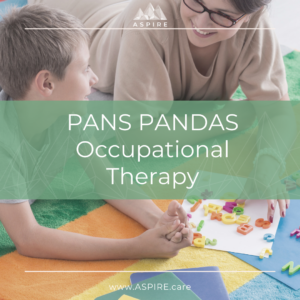
Michelle Newby, BHSc(OT), MSc discusses with ASPIRE how occupational therapy helps PANS/PANDAS patients.
Michelle Newby BHSc(OT), MSc, is a PhD Candidate at the University of Newcastle, NSW, Australia. She is also an Occupational Therapist and the Director of Stepping Stones Therapy for Children in Newcastle, NSW, Australia
Occupational Therapy for PANS/PANDAS
Occupational therapists are health professionals who work to maximize a person’s independence and participation in their life, and in the case of children, in a nutshell, we work to help them achieve their potential. Occupational Therapists are able to assess a child’s level of performance and independence and offer treatment where there is a disruption. Treatment might include skill training, individualized accommodations, or task adaptation, depending on what is appropriate for that individual child. Children with PANS/ PANDAS (PP) can struggle with different aspects of independence and participation, depending upon whether they are in a flare or not.
Sensory Tools for PANS/PANDAS
We know that many children with PANS/PANDAS can experience sensory changes during flares, and some of these changes can even stay with the child once the flare has subsided. Differences in sensory processing can change the way that children experience the world. For example, the feeling of seams or tags in clothing may suddenly become extremely irritating to a child experiencing a PP flare. This may cause behavioural outbursts or refusal to wear clothes for some children. There are many other types of sensory challenges that children with PP may experience, including disturbances in the way they experience taste, smell, sound, visual, movement, and other touch sensations.
Occupational Therapists can work with these children and their parents or caregivers to determine what their individual sensory needs are at that particular time, and develop a special program of sensory activities that the child can use throughout the day to regulate their sensory systems. This special program is called a Sensory Diet, and can help children to stay calmer and more in control of their body throughout the day.
Environmental Modification for PANS/PANDAS
From a sensory point of view, Occupational Therapists can make recommendations on how to modify the home environment to ensure that it best suits the child’s individual sensory needs. For example, this may include making recommendations about the lighting being used within the home if the child has visual sensitivities.
If a child is experiencing significant fatigue, pain or motor control challenges due to a PP flare, then an Occupational Therapist may make recommendations about different equipment or environmental modifications to help the child conserve their energy or to ensure their safety when moving around the home and performing daily activities.
Occupational Therapy and Stress Management for PANS/PANDAS
Occupational Therapists can help support well being and stress management in many different ways. They are able to work with the child and family to uncover potentially stressful triggers in their day. They can then develop a plan for minimizing those triggers or building strategies to help the child better cope with those stressors. Strategies might include specific sensory activities, mindfulness (e.g., awareness of breath), and modifying the task to minimize the stressful parts. Occupational Therapists can also support the child to understand how stress feels in their body and support the child to find effective calming strategies that can be used to prevent becoming overwhelmed by stress. This is called self-regulation training.
 Top 5 Occupational Therapy Interventions/Accommodations for PANS/PANDAS
Top 5 Occupational Therapy Interventions/Accommodations for PANS/PANDAS
- Sensory diet/ sensory calming strategies
- Self-regulation training
- Handwriting remediation for residual difficulties following a flare; and handwriting accommodations during a flare
- Feeding therapy for residual food restriction following a flare
- Strategies to support focused attention
OT Goals Change During Flares and Between Flares Absolutely! During flares, it’s often really difficult for children with PP to relearn many of the skills that are impacted by the flare. This means that when a child is unwell, the Occupational Therapist will work to adapt or provide accommodations for activities that are more difficult (e.g., recommending the use of a scribe if writing is too hard, or using a calculator if maths becomes difficult). Once the flare begins to subside, the therapist is then able to support the child to relearn any skills they may have lost during the flare. This might include handwriting therapy, feeding therapy, self-regulation training, etc.
3 comments to Occupational Therapy for PANS/PANDAS
Nannette Roach
April 15, 2021Brilliant!! I love it!
Stacy Mahon
May 12, 2021My son is 6 and we have been stuck in the initial onset flare since 12/21/20. Steroids especially have shown, while improving some symptoms, change and exacerbate others. My son’s behavior can change on a dime. Sometimes we see neurological regression, sometimes that is more baseline. Some days his fine motor and memory are better than others. We currently have him in OT, but the practitioner cannot quite grasp this understandably!
How do you teach emotional regulation when that emotion is out of the child’s control? Same with impulse control, and other behaviors. How do you follow a plan when the symptoms are so changeable?
Gabriella True
May 17, 2021Are you also working with a CBT Therapist?